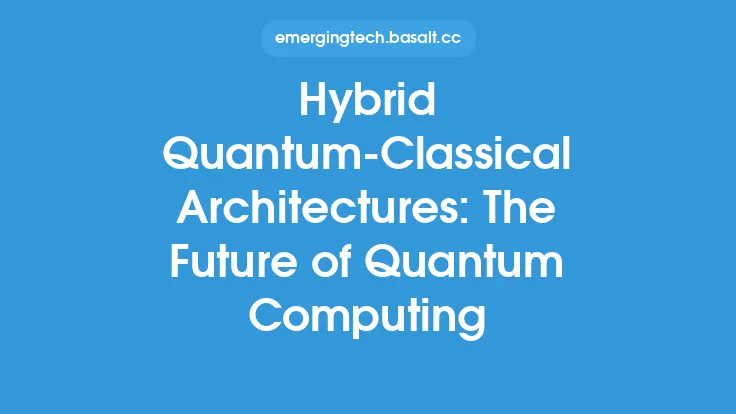The field of quantum computing has experienced significant growth in recent years, with various organizations and companies investing heavily in the development of quantum computing hardware. At the heart of any quantum computer is the quantum processor, which is responsible for executing quantum algorithms and performing calculations. However, the development of quantum computing hardware is a complex task that requires a deep understanding of quantum mechanics, materials science, and computer architecture.
Introduction to Quantum Computing Hardware
Quantum computing hardware refers to the physical components that make up a quantum computer, including the quantum processor, quantum gates, and control electronics. The development of quantum computing hardware is focused on creating systems that can reliably and efficiently execute quantum algorithms, which are the programs that run on a quantum computer. Quantum algorithms are designed to take advantage of the unique properties of quantum mechanics, such as superposition and entanglement, to solve complex problems that are difficult or impossible to solve using classical computers.
Types of Quantum Computing Hardware
There are several types of quantum computing hardware, each with its own strengths and weaknesses. Some of the most common types of quantum computing hardware include:
- Superconducting qubits: These are the most common type of quantum computing hardware and are used in many of the current quantum computers. Superconducting qubits are made from superconducting materials and use superconducting circuits to manipulate the qubits.
- Ion traps: These use electromagnetic fields to trap and manipulate ions, which are used as qubits. Ion traps are highly stable and can be used to perform high-precision calculations.
- Quantum dots: These are tiny particles made from semiconductor materials that can be used to trap and manipulate individual electrons. Quantum dots are highly scalable and can be used to perform a wide range of calculations.
- Topological quantum computers: These use exotic materials called topological insulators to create qubits that are inherently fault-tolerant. Topological quantum computers are still in the early stages of development but have the potential to be highly reliable and efficient.
Quantum Computing Hardware Components
A quantum computer is made up of several key components, including:
- Quantum processor: This is the heart of the quantum computer and is responsible for executing quantum algorithms. The quantum processor is made up of multiple qubits, which are the fundamental units of quantum information.
- Quantum gates: These are the basic operations that are used to manipulate the qubits and perform calculations. Quantum gates are the quantum equivalent of logic gates in classical computers.
- Control electronics: These are used to control the quantum processor and quantum gates, and to read out the results of calculations. Control electronics are typically made from classical components, such as field-programmable gate arrays (FPGAs) or application-specific integrated circuits (ASICs).
- Cryogenic systems: These are used to cool the quantum processor to extremely low temperatures, which is necessary for many types of quantum computing hardware. Cryogenic systems can be complex and expensive, but are essential for achieving reliable and efficient operation.
Quantum Computing Hardware Architectures
There are several different architectures that can be used to build a quantum computer, each with its own strengths and weaknesses. Some of the most common architectures include:
- Gate-based architecture: This is the most common architecture and uses a sequence of quantum gates to perform calculations. Gate-based architectures are highly flexible and can be used to perform a wide range of calculations.
- Adiabatic architecture: This uses a continuous process to perform calculations, rather than a sequence of discrete gates. Adiabatic architectures are highly efficient and can be used to solve complex optimization problems.
- Topological architecture: This uses exotic materials called topological insulators to create qubits that are inherently fault-tolerant. Topological architectures are still in the early stages of development but have the potential to be highly reliable and efficient.
- Hybrid architecture: This combines different types of quantum computing hardware, such as superconducting qubits and ion traps, to create a single system. Hybrid architectures can be highly flexible and can be used to perform a wide range of calculations.
Challenges and Opportunities in Quantum Computing Hardware
Despite the significant progress that has been made in the development of quantum computing hardware, there are still several challenges that need to be overcome. Some of the most significant challenges include:
- Scalability: Currently, most quantum computers are small-scale and can only perform a limited number of calculations. To be useful for practical applications, quantum computers need to be scaled up to thousands or millions of qubits.
- Error correction: Quantum computers are prone to errors due to the noisy nature of quantum mechanics. Developing robust methods for error correction is essential for achieving reliable and efficient operation.
- Quantum control: Maintaining control over the quantum states of the qubits is essential for performing reliable calculations. However, as the number of qubits increases, it becomes increasingly difficult to maintain control.
- Materials science: The development of new materials with improved properties is essential for advancing the field of quantum computing hardware. Researchers are currently exploring a wide range of materials, including superconducting materials, topological insulators, and semiconductor materials.
Future Directions in Quantum Computing Hardware
The field of quantum computing hardware is rapidly evolving, with new breakthroughs and advancements being made regularly. Some of the most promising future directions include:
- Quantum simulation: Quantum computers have the potential to simulate complex quantum systems, which could lead to breakthroughs in fields such as chemistry and materials science.
- Quantum machine learning: Quantum computers can be used to speed up machine learning algorithms, which could lead to breakthroughs in fields such as image recognition and natural language processing.
- Quantum cryptography: Quantum computers can be used to break certain types of classical encryption, but they can also be used to create unbreakable quantum encryption methods.
- Quantum computing for optimization problems: Quantum computers have the potential to solve complex optimization problems, which could lead to breakthroughs in fields such as logistics and finance.
Conclusion
Quantum computing hardware is a complex and rapidly evolving field, with significant potential for breakthroughs in a wide range of areas. While there are still several challenges that need to be overcome, researchers and companies are making rapid progress in the development of new quantum computing hardware architectures and technologies. As the field continues to advance, we can expect to see significant improvements in the reliability, efficiency, and scalability of quantum computers, which will be essential for achieving practical applications in areas such as simulation, machine learning, and optimization.





